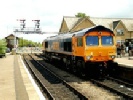Archive Section



Visit to Litchurch Lane Works
Review: Dr Paul Stewart
Date: Wednesday 20th August 2014
Thirty participants (including guests from the L&CI) gathered at the main entrance to 1 Bombardier works in Litchurch Lane. They were met by Kathryn Lancaster, Internal Communications Manager, who turned out to be very knowledgeable after 25 years work the plant (she had originally come temporarily for two weeks!), whilst having a splendid style of delivery which members appreciated.
Having moved into the Reception area, she a brief history of the works, from its inception in 1873 as the Midland Railway's Carriage Wagon Works, completed in 1876, then LMS and BR ownership and its intensely complex series of transfers and reorganisations during privatisation. The current Canadian own( Bombardier Transportation is one of the world's largest rail manufacturing and service companies.
The works now assembles and tests new trains only, repairs and other work are carried elsewhere. Kathryn pointed out that, whilst the general image of the large 88 acre site remains one of Victorian buildings, the modern construction methods inside them present a very different picture. Parts of the works (which employs 1,500 people), such as the paint and welding plants, were out of bounds owing to safety considerations, but Kathryn had arranged visit to the Design Office, a walk down Line 2 in the assembly plant, and then an opportunity to board a brand new train. Although not normally permitted, she had kindly arranged some good locations for photography. The party then walked past many buildings, including a brand new modular construction (which has, apparently, doubled in size twice!) with the telltale name board Crossrail. There were four completed District Line SSL (7-
The Design Office was visited to see the advanced Computer Aided Design systems including intensely realistic 3D, 360 degree representations of the train interiors, presented on a large screen -
Whilst each half party was inside, the other half were permitted to photograph the SSI However, no photographs of 379002 were permitted since the customer had not yet had an opportunity to see and photograph the still unbranded unit! Walking down toward the assembly lines, many trolleys containing components were waiting to be taken in. Kathryn explained that the components, many of them arriving by truck from Germany, can only arrive at specific times (not just specific days) due to limited storage space. Some, such as bogies are ready for use, whereas others have to go through pre-
The components are grouped together and labeled up for a specific vehicle, such as a driving vehicle cab or two gangways for a trailer. Thus, when a new vehicle is started, all the components are ready to be delivered to the correct place on the assembly line the moment they are required. A vehicle moves from commencement to completion on one of the six assembly lines in 60 hours and on average one new train set is produced daily. The assembly lines work two day shifts but to keep the six lines supplied, the rest of the plant operates round the clock. The two lines inspected at close quarters were both assembling SSLs (a 191 vehicle order), the other 4 lines were working on Southern Electrostars (of which 1,000 vehicles had been assembled by May) and the 5 car trailers for the London Overground Class 378 lengthening programme (57 vehicles). The Crossrail initial order is for 600 vehicles.
The process begins with roof sections, held vertically upside down whilst fitters attach all the appropriate components. Separately, the floor sections have wiring and other components added to the aluminium channels cast into the planks, before being turned 180 degrees by overhead cranes for the under floor components. These two sections are then moved forward into a jig where the pre-
The customer then re-
The tour concluded at lunchtime; some enjoying lunch in the works restaurant. Many thanks are due, and were expressed to Kathryn and all the friendly staff who were met; the impression now is of one big happy family -
